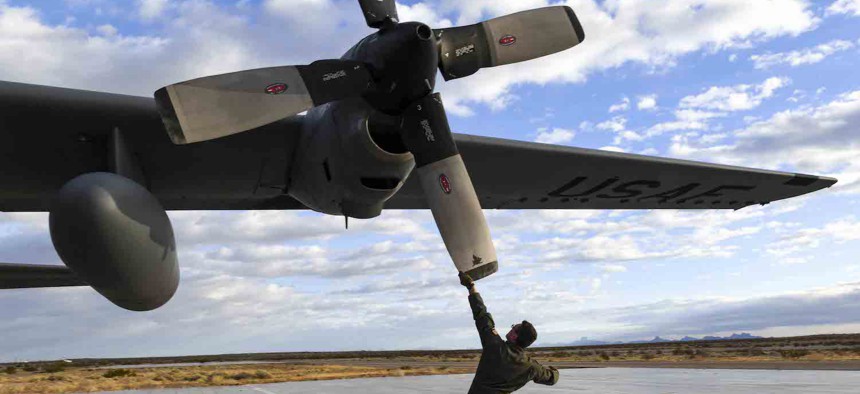
Air Force Staff Sgt. Solomon Walker prepares a C-130H Hercules aircraft for takeoff at Yuma Proving Ground, Ariz., Jan. 29, 2021. U.S. Air Force / Staff Sgt. Juliet Louden
More Than 100 C-130s Are Down, Likely Because Mechanics Scratched Their Propellers, Air Force Says
The standard practice of inscribing serial numbers during inspections turns out to be counterproductive.
A maintenance procedure used by Air Force mechanics to document inspections likely damaged hundreds of C-130 propeller blades over a decade, according to service officials.
Maintenance technicians examining the propeller blades for cracks or other damage scratched permanent marks on each blade to document the inspection had taken place.
“The process used to engrave serial numbers on the propellers likely contributed to cracks that are being found on the C-130Hs,” Maj. Beau Downey, an Air Force spokesperson, said in an email. “That process, which involved an electric arc pen to incise digits into the surface of the metal, was stopped about six months ago and will not be used going forward. Further analysis will be needed for a full understanding of the root cause of the cracks. Right now our focus is on safely and quickly returning these aircraft to supporting the mission.”
The cracks in the propeller blades’ barrels forced the Air Force to ground 116 aircraft, more than 20 percent of its C-130 fleet. While a small number of aircraft have been returned to flight, the Air Force is not saying how many remain grounded, citing operational security concerns. The propeller crashes and grounding was first reported in early October, but the cause of the damage had not previously been disclosed.
“The [Air Force] is working a multi-faceted recovery plan to resume safe aircraft operations as soon as possible,” Downey said. “This will be an incremental process based on operational priority and our focus remains the safety of our crews.”
The grounded aircraft are among the oldest C-130s in the fleet. The H-models began rolling off of Lockheed’s assembly line in the mid-1970s. The propellers were originally built by Hamilton Standard, and are still manufactured which is now part of Raytheon Technologies’ Collins Aerospace.
The etching of the propeller blades was done when aircraft were going through a complex overhaul known as “depot maintenance” at the Warner Robins Air Logistics Complex in Georgia.
“When the depot at Warner Robins Air Logistics Complex receives an unserviceable propeller hub and blade set from a field unit, they are inspected, overhauled, tested, and then prepared for shipment to the affected unit,” Downey said. “This process involves complex inspections and repairs that cannot be accomplished at the unit level outside the depot.”
The U.S. Air Force currently flies more than 483 C-130s, according to data from Forecast International, a consulting firm owned by Defense One parent company GovExec. Of those, about 200 are H-models, but only about half are grounded.
Newer C-130J aircraft, which make up the bulk of the Air Force fleet, have six-blade propellers manufactured by Dowty that have no such problems. Some National Guard wings fly H-model C-130s with special eight-bladed propellers, which are also made by Collins Aerospace. Those planes also have no issues.
“The eight-bladed propellers will deliver more power and efficiency while reducing maintenance,” according to an Air Force statement. “Due to increased thrust for takeoff and climb-out, they are also helpful in cold weather and arctic operations.”
In recent years, lawmakers have inserted funding in the Air Force budget to buy the eight-blade propellers and have criticized service leaders for not requesting the funds.
The Air Force does not know how long C-130H aircraft with cracked propeller blades will be grounded.
“Continued progress is underway in expediting the process to acquire available prop barrels, which includes scouring the globe for stock of the H model prop barrels that our maintainers can refurbish,” Downey said.
A corroded propeller blade was to blame for a 2017 Marine Corps C-130 crash that killed 15 Marines and a sailor.
The C-130 has been a workhorse of the military for six decades. Today, more than half of the Air Force’s C-130s are flown by the Air National Guard and Air Force Reserve Command. The planes are often used to deliver aid and supplies after natural disasters. More than 150 are equipped for special missions such as fighting forest fires, refueling other planes in flight, and gathering intelligence. Some are aerial gunships built to provide close air support to troops on the ground.
The H-models flown by the Air Force today entered service in the mid-1970s. The planes have received numerous updates and improvements over the years.
Lockheed Martin began building the C-130J, an aircraft with more powerful and fuel-efficient engines, in the 1990s. Lockheed builds 24 C-130J for the U.S. military and its allies each year, said Stephanie Stinn, a company spokesperson. The assembly line can produce up to 36 aircraft per year.
Don't miss:




